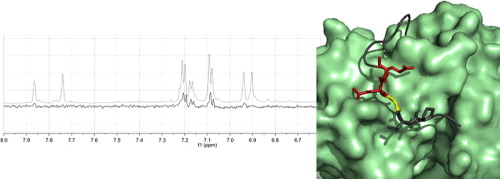Bioorganic & Medicinal Chemistry ( IF 3.5 ) Pub Date : 2017-10-28 , DOI: 10.1016/j.bmc.2017.10.036 Luisa Calvanese , Annalia Focà , Annamaria Sandomenico , Giuseppina Focà , Andrea Caporale , Nunzianna Doti , Emanuela Iaccarino , Antonio Leonardi , Gabriella D'Auria , Menotti Ruvo , Lucia Falcigno

|
Nodal is a growth factor expressed during early embryonic development, but reactivated in several advanced-stage cancers. Targeting of Nodal signaling, which occurs via the binding to Cripto-1 co-receptor, results in inhibition of cell aggressiveness and reduced tumor growth. The Nodal binding region to Cripto-1 was identified and targeted with a high affinity monoclonal antibody (3D1).
By STD-NMR technique, we investigated the interaction of Nodal fragments with 3D1 with the aim to elucidate at atomic level the interaction surface.
Data indicate with high accuracy the antibody-antigen contact atoms and confirm the information previously obtained by immune-enzymatic methods. Main residues contacted by 3D1 are P46, V47, E49 and E50, which belong to the Nodal loop involved in the interaction with the co-receptor.
中文翻译:

通过STD-NMR光谱对单克隆抗体和Nodal肽相互作用的结构见解
淋巴结是在早期胚胎发育过程中表达的一种生长因子,但在几种晚期癌症中会重新激活。通过与Cripto-1共受体结合而发生的Nodal信号传导靶向,可抑制细胞侵袭性并减少肿瘤的生长。确定了与Cripto-1的Nodal结合区,并用高亲和力单克隆抗体(3D1)进行了靶向。
通过STD-NMR技术,我们研究了Nodal片段与3D1的相互作用,目的是在原子水平上阐明相互作用表面。
数据高度准确地表明了抗体-抗原接触原子,并证实了先前通过免疫酶方法获得的信息。3D1接触的主要残基是P46,V47,E49和E50,它们属于与共受体相互作用涉及的Nodal环。



























 京公网安备 11010802027423号
京公网安备 11010802027423号